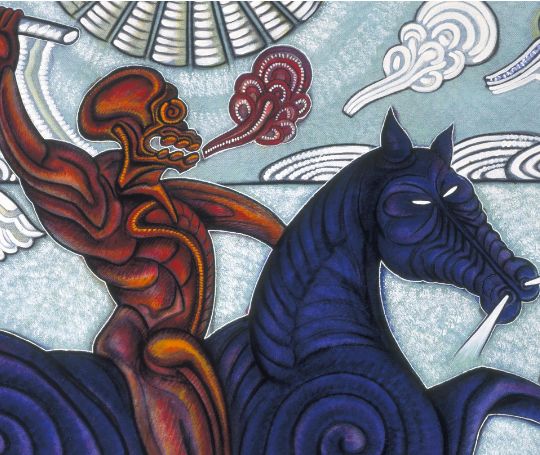THE WORK OF CARLOS LUNA

The work of Carlos Luna constructs itself over the whole basic, residual repertory of Seventies Cuban art, more specifically on the Pop models of print-making of an emblematic and nationalistic bent, in which a commitment to the popular combined the genre character of the scenes with the kitsch exuberance of unfettered ornamentalism.
The generation of the Eighties, to which Carlos Luna belongs, strove to abolish the representative complacency of the Seventies and its saccharine fondness for making any ever image into the visual panacea of our idiosyncrasy. However, Luna did more than to take up those minor keys of national discourse such as the bucolic, the everyday anecdote, the provincial picturesque, the heroes of Independence, and a certain mystical exaltation. He also reduced the theoretical challenges of his approach to the personal imagery of someone who grew up in a small tobacco town. This is a highly unusual feature in the visual arts panorama of the Eighties in Cuba.
Despite the fact that many of the resources marshaled by Luna are already documented in the work of Seventies print-makers such as Roger Aguilar, Chocolate, Nelson Domínguez and Pedro Pablo Oliva, his aesthetics, which owes something to Eighties bad painting, manages to cut itself away from the cultured strand of Cuban art to espouse a streetwise, provincial taste, where the grotesque is sublimated by the arbitrariness of color, the variety and brio of gesture, and the artisanal neatness of the enfolding outline.
The immoderateness with which Luna piles on the hatching and striping, his spiraling or oblique compositions, the contrast between figure and ground, the intense lighting and the vibrant planes of color; all these are reminiscent of the festive popular murals painted on the tin sheets of the guaraperas, or cane juice vendors; on the back of the buses, on plaster spray-painted ornaments and on carnival floats. This aesthetic kinship is more powerful than any alleged citation, much insisted upon by Luna himself, of the great modern masters in Cuba such as René Portocarrero, Wifredo Lam, Mariano Rodríguez or Amelia Peláez.
The only affinities between Carlos Luna and the rest of his generation reside in the careful design of his compositions and in certain plastic elements similar to those of José Bedia, Tomás Esson and other common sources. Nevertheless, Luna´s vivacious Pop spirit and strident graphism remind us, at their best, of the major paintings by Umberto Peña, suffused with the illustrative kitsch of lesser artists such as Ludovico or Larrinaga.
Carlos Luna´s sojourn in Mexico over the last few years has reaffirmed his interest in popular artifacts, the intimate wit of toys, and the redecorated exaltation of low-art elements transformed into middle-class stigmas. At the same time, his encounter with the great nineteenth and twentieth-century Mexican tradition of woodcutting, epitomized in the work of José Guadalupe Posada, together with his discovery of craft techniques such as paper cut-outs and enameled tin, have introduced an unmistakable “Mexicanity” into his ever more graphic output. (As regards contemporary visual arts in the country, we cannot avoid mentioning Arnold Belkin, whose work displays a number of formal correspondences in that of Carlos Luna).
It may be that Luna’s penchant for making works based on quotations from and tributes to masters and colleagues, constitutes his way of legitimating certain common sources and deliberate borrowings, which converge in the popular baroque, in kitsch and in decorative arbitrariness. It is a perpetual proclamation, from the crude stage of a village childhood, of his nostalgia for a party, which is over.

 Back to WRITINGS
Back to WRITINGS